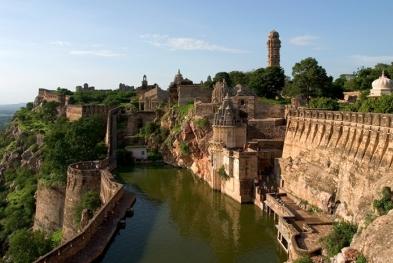|
Rajasthanís most romantic name is Chittaur. Chittorgarh is a city in
Rajasthan state of western India. Chittorgarh was founded by Bappa
Rawal in 8th century, it is located at an elevation of 408 mts above
sea level. Chittorgarh city is located on the banks of river Gambhiri
and Berach. Mirabai, 16th century poet and Rani Padmini belongs to
Chittorgarh.
The way to the Chittorgarh fort is pointed by a winding road which is
protected by seven fortified gateways. There are 7 gateways to the
main gate which are Hanuman Pol, Ganesh Pol, Bhairon Pol, Lakshman
Pol, Ram Pol, Jorla Pol, and Padan Pol. On the east there is a gate
called Suraj Pol. On the way up to the fort, there are 2 chhatris
where Kalla and Jaimal heroes of the 1568 reign fell during the fight
against Akbar. |

Chittorgarh |
|
Chittorgarh is famous for its large fort which is 495 feet high and 3
miles long and also for Kirtistambha (Tower of Victory) and
Vijaystambha. It is one of the largest fort of India and stands tall
in Chittorgarh. Chittorgarh fort is perched on a 152 m high rocky
hill. It is the symbol of Rajput pride and loyalty.The
memorial of Rawat Bagh Singh is close to the Padan Pol. When Chittor
fort was attacked second time, Rawat Bagh Singh take the help of King
Vikramaditya to fight against Bahadur Shah who was the Sultan of
Gujarat. In 1534 AD Bhairondas Solanki fought against Sultan Bahadur
Shah. Bhairon Pol is named in the remembrance of Bhairondas Solanki.
Near the Jorla Pol there are two gateways. The Lakshman Pol, the
Hanuman Pol and the Ram Pol have a temple in their surrounding area.
|
|
Chittor is
a symbol pride, spirit and romance of Rajputs people of Chittor always
chose death before surrendering against anyone. It is a symbol of all
that was true, brave and noble in the superb Rajput tradition. It is
believed historically that Chittor was built by the Maurya dynasty.
Mauryan rule ended in 271 B.C. as a dominant power in India. Chittaur
was attacked three times and on each occasion the rite of Jauhar was
performed. To avoid any harm from enemies, the children and women of
the Rajput kings done Jauhar (mass self sacrifice in a holy fire).
The first
attack was by Alauddin Khilji, the Sultan of Delhi in 1303 AD who was
enamoured by the beauty of Padmini whose face he had seen reflecting
on a mirror. Rani Padmini preferred death to abduction and committed
jauhar along with all the other ladies of the fort.
The second was in 1533 when the Sultan of Gujarat attacked Bikramjeet
of Chittaur. Rani Karnavati, a Bundi Princess, take the Jauhar in
which many children and women perished. The ultimate sacrifice for
freedom Jauhar was again performed for the third time after the Mughal
Emperor Akbar captured Chittorgarh in 1568.
Then the capital was moved west to Udaipur in the foothills of the
Aravalli Range where Rana Udai Singh II had established a residence in
1559. Udaipur remained the capital of Mewar until it acceded to the
union of India in 1947 and Chittorgarh gradually lost its political
importance. Chittorgarh remains replete with historic associations and
holds a very special place in the hearts of Rajputs, as it was a
bastion of the clan at a time when every other stronghold had
surrendered to attack. It is often called as the "Bhakti aur Shakti ki
nagari"
It is also
considered that Bhim, one of the hero of the epic Mahabharta visited
this place to learn the secrets of immortality and became the devotee
of a saint, but his anxiety to perform all the rites deprived him of
his goal and out of anger he stamped on ground creating water
reservoir, this reservoir is now known as Bhim Lat. According to a
belief in the middle of 8th century the founder of the Sisodia clan,
Bappa Rawal received Chittaur, as a part of the dowry after marriage
with the last Solanki princess. His descendants ruled Mewar upto 16th
century after that which extends from Gujarat to Ajmer. |